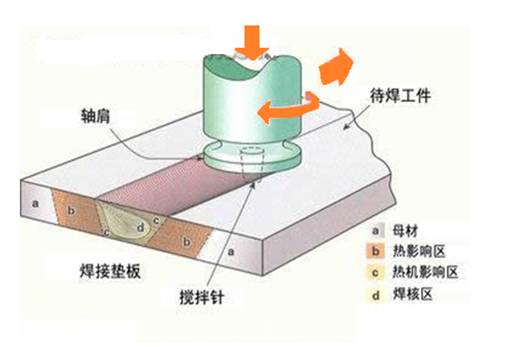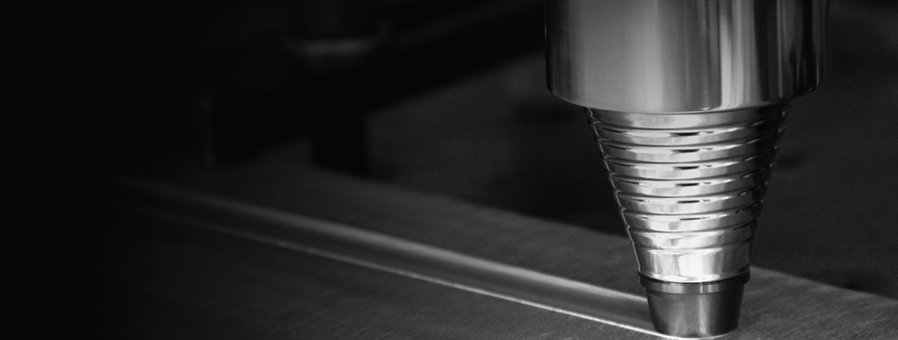Principle of friction stir welding
Friction stir welding (FSW) is a new solid-state joining technology proposed by the British Welding Research Institute in 1991.
 | The principle of FSW is to insert a high-speed rotating mixing tool into the metal to be welded, and make the mixing tool move forward at a certain speed (generally, the mixing head is inclined to the rotating side 3 ° - 5 ° relative to the vertical line of the weld seam). The metal to be welded is heated to the plastic state (the temperature during welding is lower than the melting point, about 80% of the melting point) by the rotation of the shaft shoulder and the mixing needle, while the mixing tool Move forward, extrude and stir the plastic material to form a stable flow field. At the place where the mixing head moves, with the movement of the mixing tool, the temperature gradually cools and solidifies to form the weld. Its working principle is shown in the figure. |
Friction stir welding method:
Static shoulder welding: the shoulder is separated from the mixing needle. During welding, the mixing needle rotates independently, and the shaft shoulder slides on the surface of the material to be welded. Compared with the traditional friction stir welding process, the static shoulder friction stir welding can reduce the heat input during welding, obtain the uniform thermal gradient in the thickness direction, and improve the surface quality of the joint. The static shoulder friction stir process is suitable for the welding of aluminum alloy thick plate, fillet weld and titanium alloy with low heat conductivity.
Biaxial shoulder welding: as a new friction stir welding method, it is a supplement to the traditional friction stir welding technology. Double shoulder self-supporting technology can weld the upper and lower surfaces of the workpiece at the same time, and fundamentally eliminate the problems such as incomplete penetration or root defects. Through the key technology research, safost has achieved the flawless welding of the thickest 45mm aluminum alloy double shoulder friction stir welding, with beautiful weld formation and excellent joint performance, reaching the world's advanced level.
Returnable welding: it is an effective supplement to the traditional friction stir welding method to gradually withdraw the mixing needle at the end of the friction stir welding to realize the "keyless hole" friction stir welding. Beijing saifoster has filled in the domestic blank in the field of returnable FSW tools, which can realize the flawless welding of keyless FSW of the thickest 30mm aluminum alloy material, with beautiful weld formation and excellent joint performance, reaching the world advanced level.
Spot welding: a new welding technology developed on the basis of friction stir welding. Compared with traditional single point connection method (resistance spot welding, riveting), friction stir spot welding does not require simultaneous interpreting of large power and cooling devices, without additional materials, and has the advantages of low energy consumption, low cost, and material saving. Beijing saiforster spot welding technology has successfully realized the friction stir welding with hole, backfill and swing. The welding spot has beautiful shape and dense internal organization.
Fillet weld: it is the latest research topic of FSW in recent years, and it is the extension and expansion of traditional FSW technology. Safost has successfully broken through many technical problems such as FSW fillet welding equipment, tooling, mixing tools, etc. on the basis of the transformation of the original equipment, the static shoulder technology is adopted to carry out repeated FSW experiments, and a variety of thickness of FSW fillet welds are realized.




